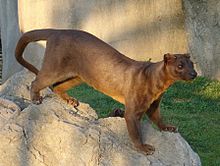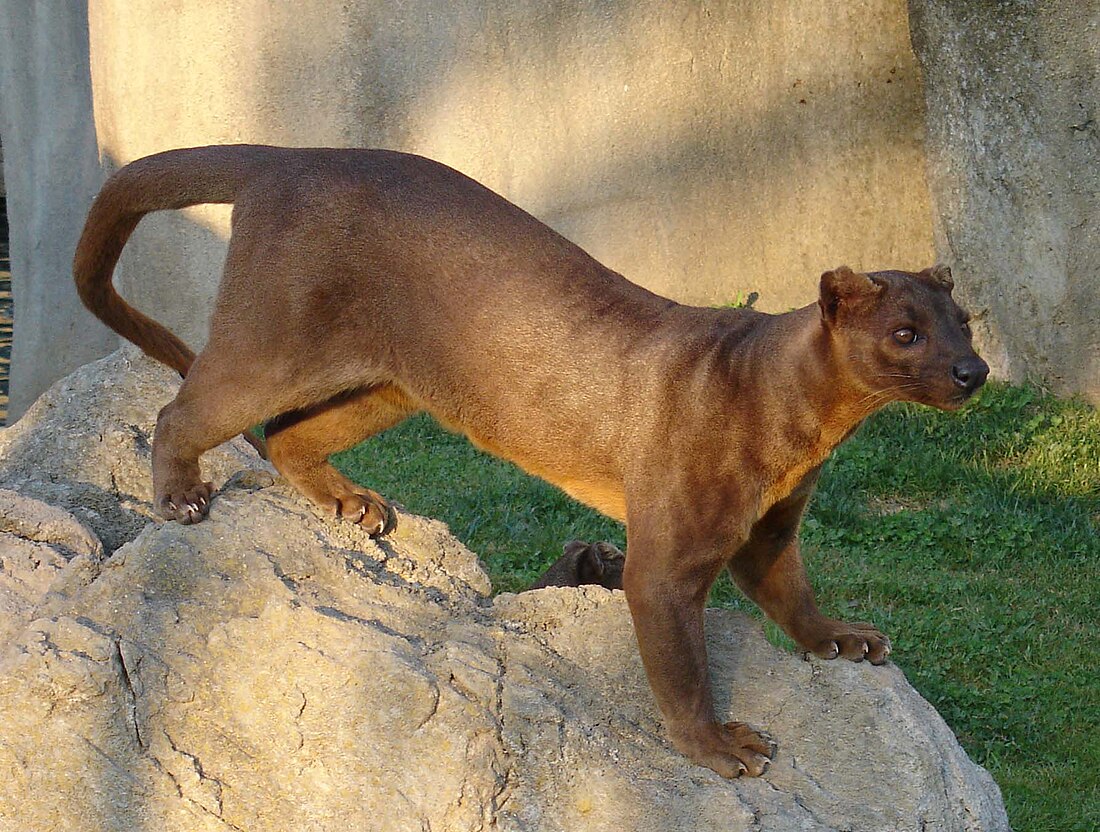The fossa (Cryptoprocta ferox) is a cat-like, carnivorous mammal endemic to Madagascar. It is a member of the Eupleridae, a family of carnivorans closely related to the mongoose family (Herpestidae).
| Fossa[1] | |
|---|---|
 | |
| Scientific classification | |
| Domain: | Eukaryota |
| Kingdom: | Animalia |
| Phylum: | Chordata |
| Class: | Mammalia |
| Order: | Carnivora |
| Suborder: | Feliformia |
| Family: | Eupleridae |
| Genus: | Cryptoprocta Bennett, 1833 |
| Species: | C. ferox |
| Binomial name | |
| Cryptoprocta ferox Bennett, 1833 | |
 | |
| Distribution of Cryptoprocta ferox[2] | |
| Synonyms | |
| |
Its classification has been controversial because it looks like a cat. However, other traits suggest a close relationship with viverrids (most civets and their relatives). Its classification influenced thought about how many times mammalian carnivores had colonized Madagascar. Genetic studies now show that the fossa and all other Malagasy carnivores are closely related to each other: they are a clade, the family Eupleridae. Carnivorans are now thought to have colonized the island once about 18 to 20 million years ago.
The fossa is the largest mammalian carnivore on the island of Madagascar and has been compared to a small cougar. Adults have a head-body length of 70–80 cm (28–31 in) and weigh between 5.5 and 8.6 kg (12 and 19 lb). The males larger than the females. It has semiretractable claws and flexible ankles that allow it to climb up and down trees head-first, and they can jump from tree to tree.
The species is widespread, although population densities are usually low. It is found only in forested habitat, and hunts by day and night. Over 50% of its diet consists of lemurs, the endemic primates of the island. Tenrecs, rodents, lizards, birds, and other animals are also prey. Mating usually occurs in trees on horizontal limbs and can last for several hours. Litters range from one to six pups, which are born blind and toothless (altricial). Infants wean after 4.5 months and are independent after a year. Sexual maturity occurs around three to four years of age, and life expectancy in captivity is 20 years. The fossa is listed as "Vulnerable" by the International Union for Conservation of Nature. It is generally feared by the Malagasy people and is often protected by their taboo. The greatest threat to the species is habitat destruction.
References
Wikiwand in your browser!
Seamless Wikipedia browsing. On steroids.
Every time you click a link to Wikipedia, Wiktionary or Wikiquote in your browser's search results, it will show the modern Wikiwand interface.
Wikiwand extension is a five stars, simple, with minimum permission required to keep your browsing private, safe and transparent.

